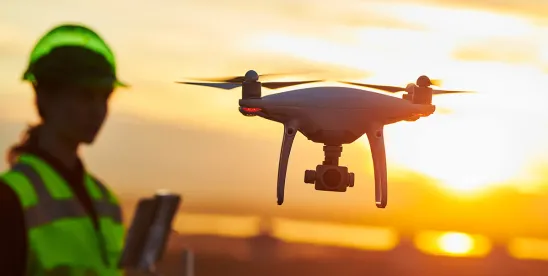Go-to Guide:
- Domestic Drone Industry Boost: Two executive orders prioritize strengthening U.S. drone manufacturing, reducing reliance on foreign-made drones, and increasing export opportunities for American drone companies.
- Procurement and Use Restrictions: Federal agencies are directed to prioritize American-made drones for procurement and operation, while new regulations tighten restrictions on drones produced by certain foreign entities.
- Airspace Security and Counter-UAS Measures: The orders expand the use of drones for national security and law enforcement, enhance detection and tracking capabilities, and create a federal task force to address drone-related threats.
- Regulatory and Funding Changes: Federal agencies must update regulations to integrate drones into U.S. airspace, enable beyond-visual-line-of-sight operations, and provide grants to support state and local acquisition of drones and counter-UAS technologies.
On June 6, 2025, President Trump issued Executive Orders (E.O.) 14307, “Unleashing American Drone Dominance,” and 14305, “Restoring American Airspace Sovereignty.” The two executive orders are intended to promote unmanned aircraft system (UAS) manufacturing in the United States, increase commercial use of drones in U.S. airspace, expand the use of drones for national security, and enhance the country’s counter-UAS capabilities. E.O. 14307 focuses on strengthening the United States’ domestic drone industry and decreasing the country’s reliance on drone imports, while E.O. 14305 concentrates on utilizing drones and counter-UAS technology in enforcing U.S. laws and protecting the country’s national security interests.
The executive orders followed the publication of an acquisition regulation prohibiting the delivery of drones produced by certain foreign covered entities and, on Dec. 22, 2025, prohibiting the use of such drones in the performance of a contract and the use of federal funds to procure or operate such covered drones. The executive orders place further restrictions on foreign drones while increasing opportunities for domestic sources of drone technologies in both government and commercial sectors.
Executive Order 14307: ‘Unleashing American Drone Dominance’
In E.O. 14307, “Unleashing American Drone Dominance,” Trump issued a series of directives that, collectively, seek to establish a “strong and secure domestic drone sector” to strengthen American supply chains and reduce the country’s reliance on foreign UAS. E.O. 14307 seeks to facilitate growth in the American drone industry through two primary mechanisms: (1) it prioritizes federal agencies’ procurement and operation of American drones, and (2) it institutes policies and programs that support the development, testing, and scaling of American drone technologies. Through facilitating drone innovation in the United States and strictly reserving government procurement opportunities for American drone companies, E.O. 14307 intends to create an economic environment more favorable for building an independent and robust domestic drone industry.
All federal agencies are directed to “prioritize the integration of UAS manufactured in the United States over those made abroad to the maximum extent permitted by law.” The order directs the Secretary of Defense to prioritize drones U.S. companies make in procurement efforts and leverages the Defense Innovation Unit’s Blue UAS program (a streamlined procurement system exclusive to approved UAS) to accelerate the procurement of drones that U.S. companies manufacture.
To ensure the availability of domestic drones, the executive order requires all FAA UAS Test Ranges to support the development, testing, and scaling of American drone technologies; expands access to airspace for UAS testing; and establishes an electric Vertical Takeoff and Landing (eVTOL) pilot program to accelerate the development of eVTOL aircrafts.
To increase economic opportunities for American drone companies, E.O. 14307 intends to promote their success in foreign markets. It directs certain agencies to prioritize and support the export of U.S.-manufactured civil UAS through various incentive mechanisms: direct loans and guarantees; equity investments and co-financing; political risk insurance and credit guarantees; technical assistance, feasibility studies, and grant mechanisms; and market access facilitation. The order also calls on the Secretary of Commerce to amend export control regulations within 90 days to facilitate the accelerated export of U.S.-manufactured civil UAS to foreign partners.
While prioritizing American drones, the order tightens restrictions on federal agencies using drones that foreign companies manufacture. Consistent with the new acquisition regulation, the Federal Acquisition Security Council (FASC) must publish a Covered Foreign Entity List identifying companies that pose supply chain risks in drone development within 30 days. Currently, the list includes all companies on the Consolidated Screening List. Companies on this list may face significant restrictions under sections 1823–1827 of the FY2024 NDAA and section 848 of the FY2020 NDAA. While the Secretary could, in certain circumstances, bypass restrictions on foreign-made drones under Section 848 of the FY2020 NDAA, E.O. 14307 limits the Secretary’s discretion by only allowing exemptions and waivers when necessary to accomplish the military’s mission.
Additionally, E.O. 14307 aims to increase the routine use of drones in the United States. In accordance with the order’s directives, the Department of Transportation issued a proposed rule on Aug. 7, 2025, to enable Beyond Visual Line of Sight drone operations for commercial and public safety purposes. The Department of Transportation must also publish an updated roadmap for the integration of civil UAS into the National Airspace System within 240 days.
Executive Order 14305: ‘Restoring American Airspace Sovereignty’
In response to growing concerns over illicit drone activity, Executive Order 14305, titled “Restoring American Airspace Sovereignty,” emphasizes the need to reinforce U.S. control over its airspace and uphold the safety and autonomy of its skies. To facilitate compliance, the order establishes the Federal Task Force to Restore American Space Sovereignty to review relevant operational, technical, and regulatory frameworks for the development and proposal of solutions to UAS threats, as appropriate and applicable. Companies using or providing drone technologies should be aware of several provisions in this executive order that may impact current use and operation of drone technologies.
- Executive departments and agencies must utilize all existing federal authorities to deploy equipment capable of detecting, tracking, and identifying drones and their signals.
- The Attorney General and Secretary of Homeland Security must also ensure that both departments’ grant programs allow eligible state, local, tribal, and territorial (SLTT) agencies to obtain funding for the acquisition of UAS, as well as equipment or services used for the detection, tracking, or identification of drones and their signals.
- The FAA must provide authorized federal and SLTT agencies with synchronous access to personal identifying information linked to UAS remote identification signals, for the purpose of enforcing applicable federal or state law, and with appropriate national security and privacy safeguards.
Guidance is expected to be forthcoming from the Attorney General, Secretary of Transportation, Secretary of Homeland Security, and Chairman of the Federal Communications Commission regarding updates to federal law and regulations concerning drones. The FAA and DHS, in coordination with other Sector Risk Management Agency (SRMA) leaders, will issue guidance to assist private critical infrastructure owners and operators in deploying drone detection technologies.
The order also contains provisions addressing potential increases in the use of drones for federal law enforcement purposes. The Secretary of Homeland Security and the Attorney General, in coordination with the Secretaries of Defense and Transportation, must make a recommendation on whether the northern and southern land borders, major airports, federal facilities, critical infrastructure, and military installations should be designated as covered facilities or assets. To enhance protection for mass gathering events, the Attorney General and the Secretary of Homeland Security must also consider incorporating counter-UAS operational capabilities into Joint Terrorism Task Forces.
Conclusion
Executive Orders 14305 and 14307 describe opportunities and risks for the drone sector. There may be new opportunities for domestic suppliers as stricter limitations are imposed on the use of foreign-made UAS. The executive orders contemplate enhanced government contracting prospects by calling for greater utilization of domestically manufactured drones across federal and state agencies. Simultaneously, the federal government may also be looking to increase detection, tracking, and identification capabilities regarding drone use. Further guidance is expected to be forthcoming regarding the use and operation of drones in American airspace. Companies that manufacture or use drone technologies should consider closely following these developments to help ensure they are compliant with current and future restrictions, authorizations, and reporting requirements.
*Special thanks to Government Contracts Project Assistant Millie Koehler and Summer Associate Jack Long˘ for contributing to this GT Alert.
˘ Not admitted to the practice of law.





 />i
/>i
